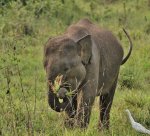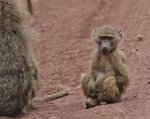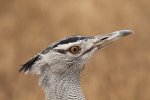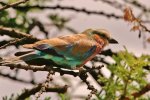-
CONTACT US if you have any problems registering for the forums.
You are using an out of date browser. It may not display this or other websites correctly.
You should upgrade or use an alternative browser.
You should upgrade or use an alternative browser.
A beginner's guide to safari holidays
- Thread starter GDB
- Start date
Elephants can be seen in Africa and Asia, but I am afraid that despite the efforts of many charities, NGOs and governments, there is still an ivory trade to the far east..... it beggars belief that these wonderful creatures are gradually but surely wiped out. It is estimated that there is an elephant murdered every 25 minutes in Africa... yes , between 50 -60 a day !!
Here is part of a family we saw in the Serengeti, just having fun. We also visited the neighbouring national park of Tarangire which is famous for its elephants and lost count of the numbers we saw after 150. Fortunately there are still places where they are being protected quite well, and Tanzania is one of them.

Here is part of a family we saw in the Serengeti, just having fun. We also visited the neighbouring national park of Tarangire which is famous for its elephants and lost count of the numbers we saw after 150. Fortunately there are still places where they are being protected quite well, and Tanzania is one of them.

These figures are from one of the most reputable charities, Born Free. I know that I witter on about what we can do about it, but the main thing is to just go to these places if you can, have wonderful experiences of seeing these beautiful creatures in their own world behaving naturally, and knowing that you are contributing to the local economy and to their protection.
This next image was taken quite close up and we were very privileged to see this young one happily chomping away and completely oblivious to us...

This next image was taken quite close up and we were very privileged to see this young one happily chomping away and completely oblivious to us...

I have checked and it is actually the Kori Bustard...... He is in the same bustard family and certainly has the similar head and beak shape, but the Kori is definitely bigger than the Great. The male, who is considerably larger than the female, will stand well over 4' ht. and weigh up to 30lbs. or more. It is said that this species is probably the heaviest animal to fly. The Jabiru Stork, which we have seen before, is definitely taller but is only half the weight of the Kori Bustard.
I read that there is a contingent of Great Bustards resident now on Salisbury Plains ??
I read that there is a contingent of Great Bustards resident now on Salisbury Plains ??
Last edited:
Of course an African safari wouldn't be complete without seeing lions. Generally lions are quite habituated with humans and will tolerate you staring at them at quite close range. One must not abuse that privilege.... this time however we did feel just a little in the way; it was clear that these two youngsters were very fond of each other.... we called this shot.... Young Love. I hope you agree.


You cheeky thing..... but you are quite right, he does look somewhat orange. My initial check back to the original image and it is no different. To my knowledge there is not an orange breasted version, but |I stand to be corrected. All the other colours on this image seem to correlate to a Lilac Breasted Roller, so it's possible that he is an immature adult..? I will do some further checks.
My apologies that standards are dropping.
Did you like the lions though ?
My apologies that standards are dropping.
Did you like the lions though ?
The spotted Hyena is a fairly common sight in most parts of Africa. This one stared at us for some time... we were a little too close. They do have very strong family units, and are amongst the most formidable when hunting together. They are renowned for stealing kills from other animals, quite often the big cats. One to one, a hyena would not stand a chance against a full grown lioness for example. Even two would be very wary, but three or even four will make the lioness back off and leave her kill for these arch scavengers..


One needs to be careful, as a first timer to India, in choosing a Tiger reserve. GDB is spot on while suggesting Bandhavgarh, Ranthambhore, and Kanha. The density of tigers in these parks is very healthy. One is reasonably sure of seeing one, in 3 to 6 game drives. Some other Indian parks have numbers which is merely a statistical data!
The visibility in these parks is greater than say in the Corbett where the dense undergrowth helps camouflaging a tiger though he may just be no more than 10 feet away. I have personally known instances when the tiger was right in the middle, and not a bird or animal called to announce his presence, totally oblivious. The langur, monkeys and the barking deer has a very keen eye.
The Indian jungles are very productive during the evening drives, which should not be missed. Although, in the Central Indian Parks there is more time in the mornings. The reason is that the herbivores leave the lengthening shadows of the tree jungle and come out in the open areas to feed. These are followed by the tiger for he has rubbed off his slumber, had a drink at a pool and is ready to hunt. Anyone of us who have had the privilege of sitting out on a moonlit night will know how the hunted move in the lit up areas and the hunter cling to shadows.
These are very gentle animals. The only time he may get aggressive is during the mating season when the male likes to show-off. I see a lot of videos shot and what is no more than a playful charge (if it could be called one), dubbed as a tiger-attack! An elephant in close proximity is frightening but not a tiger…he induces immense excitement…if followed closely on an elephant he will warn you by a deep throated growl…lay-off!!
Some very enlightening books can be read on this subject, by Dunbar Brander, Burton, Schaller, Arjan Singh, Kesri Singh & Corbett.
Ladies & gents, one gets hooked to this form of sport, it is a magnet that will draw you back time and again to an Indian jungle!
Happy travels!!
The visibility in these parks is greater than say in the Corbett where the dense undergrowth helps camouflaging a tiger though he may just be no more than 10 feet away. I have personally known instances when the tiger was right in the middle, and not a bird or animal called to announce his presence, totally oblivious. The langur, monkeys and the barking deer has a very keen eye.
The Indian jungles are very productive during the evening drives, which should not be missed. Although, in the Central Indian Parks there is more time in the mornings. The reason is that the herbivores leave the lengthening shadows of the tree jungle and come out in the open areas to feed. These are followed by the tiger for he has rubbed off his slumber, had a drink at a pool and is ready to hunt. Anyone of us who have had the privilege of sitting out on a moonlit night will know how the hunted move in the lit up areas and the hunter cling to shadows.
These are very gentle animals. The only time he may get aggressive is during the mating season when the male likes to show-off. I see a lot of videos shot and what is no more than a playful charge (if it could be called one), dubbed as a tiger-attack! An elephant in close proximity is frightening but not a tiger…he induces immense excitement…if followed closely on an elephant he will warn you by a deep throated growl…lay-off!!
Some very enlightening books can be read on this subject, by Dunbar Brander, Burton, Schaller, Arjan Singh, Kesri Singh & Corbett.
Ladies & gents, one gets hooked to this form of sport, it is a magnet that will draw you back time and again to an Indian jungle!
Happy travels!!
How to Find Information
Search using the search button in the upper right. Search all forums or current forum by keyword or member. Advanced search gives you more options.
Filter forum threads using the filter pulldown above the threads. Filter by prefix, member, date. Or click on a thread title prefix to see all threads with that prefix.
Recommended Guides, Apps and Books
52 Things to See and Do in Basilicata by Valerie Fortney Italian Ancestral Journeys by Bryan Schneider Italian Food & Life Rules by Ann Reavis Italian Food Decoder App by Dana Facaros, Michael Pauls French Food Decoder App by Dana Facaros, Michael Pauls She Left No Note, Lake Iseo Italy Mystery 1 by J L Crellina Tuscan Traveler, Living in Italy by Ann Reavis





